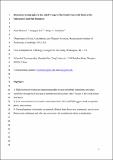Biomarker stratigraphy in the Athel Trough of the South Oman Salt Basin at the Ediacaran‐Cambrian Boundary
Author(s)
Roussel, Anaïs; Cui, Xingqian; Summons, Roger E
DownloadAccepted version (3.251Mb)
Open Access Policy
Open Access Policy
Creative Commons Attribution-Noncommercial-Share Alike
Terms of use
Metadata
Show full item recordAbstract
The South Oman Salt Basin (SOSB) has been studied extensively for knowledge concerning the habitat of the enigmatic Ediacaran–Cambrian oils that are produced from that region. Geological, geochemical, geophysical, and geochronological investigations have all contributed to improved understanding of the range of late Neoproterozoic depositional environments recorded there. Of particular interest has been the deep Athel depocenter within the SOSB that features a silica-rich interval known as the Al Shomou Member or Athel Silicilyte and the co-eval A4 carbonate–evaporite sequence that straddles the Ediacaran–Cambrian boundary. The deep basin has been suggested to be anoxic and euxinic based on studies of sulfur isotopes, trace metal distributions and other proxies. Organic geochemistry has provided some clues concerning aspects of the depositional environments and microbial communities prevailing during this interval. However, ambiguities remain including a paucity of convincing molecular evidence for euxinia in the photic zone of the basin. Here, we present a comprehensive study of biomarker hydrocarbons, including steroids, triterpenoids, and carotenoids. Among the compounds detected is a distinctive array of aromatic carotenoids. Relatively low abundances of monoaromatic carotenoids, such as chlorobactane, okenane, and β-isorenieratane, suggest the possibility of transient photic zone euxinia with a shallow chemocline or, perhaps, exogenous inputs from microbial mats. However, it is the dominance of renieratane and renierapurpurane over isorenieratane in diaromatic carotenoids and their association with abundant C38 and C39 carotenoids that identifies cyanobacteria as major contributors to the inventory of carotenoids. Our results, based on multiple lines of molecular evidence and statistical analysis, also suggest that the Athel Silicilyte was biogeochemically distinct from the other units of the Ara Group. Overall, our study has important implications for understanding other late Neoproterozoic depositional environments.
Date issued
2020-07Department
Massachusetts Institute of Technology. Department of Earth, Atmospheric, and Planetary SciencesJournal
Geobiology
Publisher
Wiley
Citation
Roussel, Anaïs et al. "Biomarker stratigraphy in the Athel Trough of the South Oman Salt Basin at the Ediacaran-Cambrian Boundary." Geobiology 18, 6 (July 2020): 663– 681. © 2020 John Wiley & Sons Ltd
Version: Author's final manuscript
ISSN
1472-4677
1472-4669